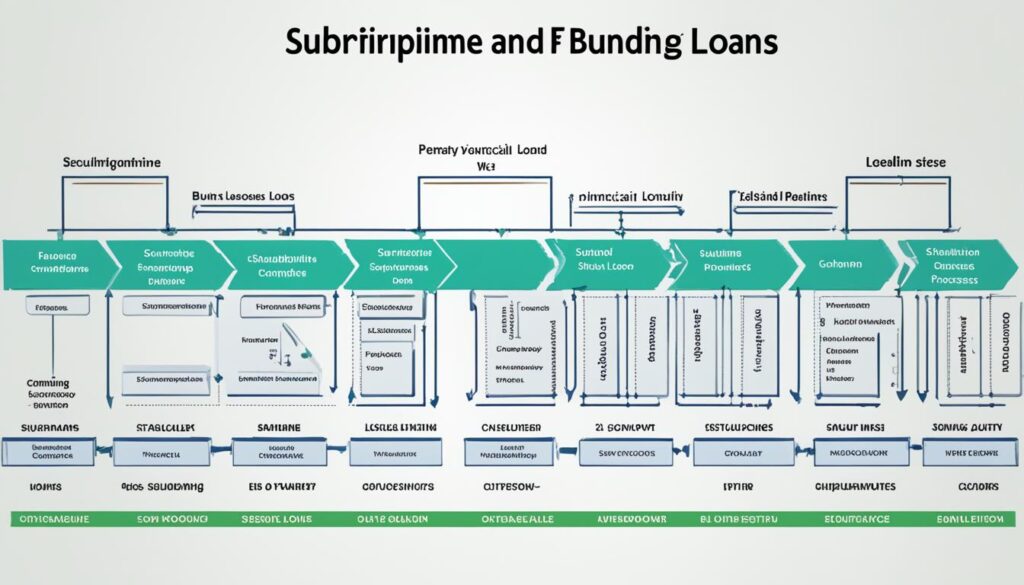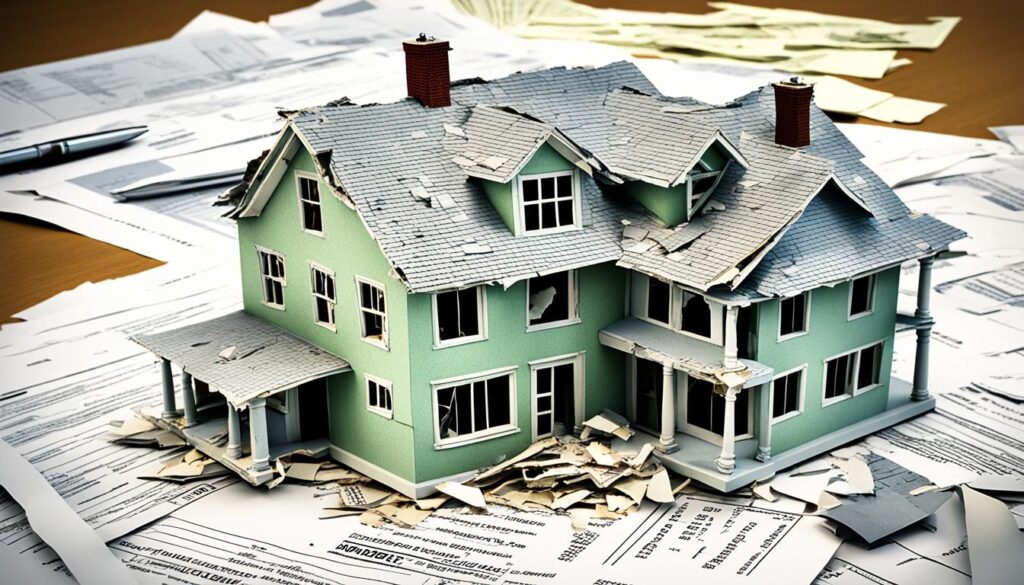The subprime loan market is a big part of finance, helping people who don’t fit the norm for regular loans. These subprime loans offer money at a cost – usually higher interest rates and more flexible credit score rules. They are key in the economy, giving a chance to those who usually don’t get lending offers.
Subprime loans are for people with not-so-great credit or who don’t have much. These lenders might ask for higher interest rates due to the risks they take. Even though this market faced tough times like the financial crisis and the subprime mortgage crisis, it remains vital for offering financing to those turned down by regular banks.
Key Takeaways
- Subprime loans cater to borrowers with poor credit histories or limited resources, often charging higher interest rates to compensate for the increased credit risk.
- The subprime market has played a significant role in providing access to financing for those who might not qualify for traditional prime loans.
- Subprime loans include subprime mortgages, auto loans, and personal loans, and have been the subject of scrutiny, particularly during the financial crisis and subprime mortgage crisis.
- The subprime market continues to be an important component of the broader financial landscape, offering financing options for borrowers who may not meet the criteria for conventional loans.
- Understanding the role and dynamics of the subprime loan market is crucial for policymakers, lenders, and borrowers alike to ensure responsible and sustainable lending practices.
Understanding the Subprime Market
The subprime market is a key part of the money world. It helps people who don’t fit the usual lending rules. These subprime borrowers often face credit issues, have little to show on their credit reports, or can’t prove their incomes. This makes them riskier to lenders.
The Subprime Borrower
Some fall into the subprime category for many reasons. This includes bad credit history, low credit scores, or not much money. It’s the case for new graduates, recently arrived immigrants, or those without much credit history. Others might have a good credit history but lack proof of income or assets when applying for a loan.
Subprime Loan Products
Lenders created special loan products for subprime borrowers. These include stated income and stated asset (SISA) loans and no income, no asset (NINA) loans. They aim to provide mortgage, car, and other loans. This is for people who don’t meet the strict rules of traditional lenders.
Higher Interest Rates for Subprime Loans
Because subprime borrowers are riskier, lenders charge them more interest. So, subprime loans have higher interest rates. The rates are much more than what prime borrowers get. This means it’s harder for subprime borrowers to pay their loan obligations each month.
| Loan Type | Interest Rate Range | Key Features |
|---|---|---|
| Subprime Mortgage Loans | 8% to 15% | Designed for borrowers with poor credit history or limited resources, often requiring collateral such as the borrower’s home. |
| Subprime Auto Loans | 10% to 20% | Offered to high-risk borrowers with flawed credit ratings or poor credit history, with the vehicle serving as collateral. |
| Subprime Personal Loans | 15% to 36% | Unsecured loans targeted at subprime borrowers with limited credit options, often used for debt consolidation or unexpected expenses. |
| Payday Loans | 300% to 500% | Short-term, high-interest loans offered to subprime borrowers with immediate cash needs, typically due on the borrower’s next payday. |
The subprime market helps those who can’t get normal loans. But, interest rates are high, making it tough for subprime borrowers.
The Rise of Subprime Lending

The subprime market in the U.S. started growing in the mid-1990s. This happened when major banks and specialized lenders saw a chance to make big profits. By loosening their lending standards, they could help people with low or no credit scores. This made it easier for them to buy homes, cars, start businesses, or study for a degree. With the promise of higher interest margins, lenders started working more in this area to reach out to more customers.
Relaxed Lending Standards
More and more mortgage lenders began to lower their credit requirements. They started approving loans for people with poor credit or a thin credit history. This change towards relaxed lending standards opened up new opportunities. Now, more people could get loans, even if they were refused before because of credit scores.
Securitization of Subprime Loans
The subprime lending boom got even bigger because of securitization of subprime loans. This meant that mortgage lenders could bundle these risky loans into financial products. Then, they could sell these products to institutional investors. With this new source of money, lenders could give out even more subprime loans. This was a key factor in the housing bubble and the jump in home equity loans and home prices.
Subprime Loan and the Housing Bubble

From 2007 to 2010, the markets were in chaos due to risky mortgages and high home prices. In the 2000s, lenders started offering subprime loans. They would take these loans and sell them to investors as private-label mortgage-backed securities. This practice quickly spread, leading to more people owning homes.
Inflated Home Prices
Home prices shot up thanks to competitive home buying and easy credit. Many homeowners borrowed against their home equity using home equity loans. This extra money fueled more spending, helping create the housing bubble.
Subprime Mortgage Crisis
Relaxed lending resulted in many failing to pay their mortgages, causing a collapse. Investors lost when the mortgage-backed securities they bought turned worthless. This event, the subprime mortgage crisis, was a key player in the 2007-2008 financial crisis.
Impact of the Subprime Crisis

The subprime crisis from the late 2000s deeply affected the economy. It led to a long recession and a lot of financial chaos. There was a big drop in building new homes and many homes were taken back by banks.
Recession and Financial Market Turmoil
The housing market fell apart and many people couldn’t pay their home loans. This trouble spread through the financial system. It made people spend less and caused the economy to slow down. Companies that lend money also found it hard to operate. Their investments in home loans lost a lot of value.
Decline in Housing Construction
Because fewer people wanted new homes, building stopped. Even big groups like Fannie Mae and Freddie Mac struggled. They usually help make home loans. They needed the government’s help to survive.
Foreclosures and Repossessions
Lots of homes were taken by banks because their owners couldn’t pay. This made house prices drop even more. The entire economy felt the effects. People didn’t want to buy homes, even if they could afford them.
Government Intervention
The government acted to lessen the subprime crisis’s impact. They urged lenders to change payment terms on mortgages in trouble or help with refinancing on underwater mortgages. This kept repossessions down, which would have lowered house prices even more. They also gave temporary tax credits to homebuyers during 2009 and 2010. This helped keep housing demand up and softened the drop in house prices.
Mortgage Modifications and Refinancing
The government supported homeowners facing foreclosure. They made programs that encouraged lenders to change or refinance mortgages in trouble. These steps were to stop house prices from falling and to stabilize the housing market.
Federal Reserve’s Monetary Policy
The Federal Reserve was crucial in the government’s reply. They lowered interest rates and bought long-term assets. These monetary policy steps helped in mortgage refinancing and kept the housing market steady. They aimed to make funds available for lenders, which supported the housing market.
Housing Policy Changes
The government also changed housing policy, setting new rules and programs. They adjusted FHA loan limits and started new efforts to prevent foreclosures. Their aim was to help troubled mortgages, avoid foreclosures, and support mortgage refinancing. These actions were meant to stabilize the housing market.
Subprime Loan Regulations

After the subprime crisis, new rules were set. The Dodd-Frank Wall Street Reform Act and similar laws in many countries aimed to control risky lending. They put in place measures to make the financial system clearer and safer for consumers. This included watching over things like securitization of mortgages more closely.
Dodd-Frank Wall Street Reform Act
The Dodd-Frank Act tackled issues in America’s financial system on a big scale. Passed in 2010, it aimed to stop another crisis like the one in 2008. It did this by setting up stronger rules for mortgage-backed securities and other financial products.
Consumer Protection Measures
The Dodd-Frank Act also looked out for consumers. It worked to stop unfair securitization of loans and protect people from bad loan practices. It made sure lenders checked if borrowers could pay back loans and put limits on risky loan features. The Act also created the Consumer Financial Protection Bureau (CFPB). This group makes sure the rules protect consumers.
These new laws aimed to fix the root of the problem. They made the lending world clearer and safer. By improving how things work and protecting consumers better, they hoped to avoid another financial crisis.
Subprime Loan
In the lending world, “subprime” means loans are given to those with lower credit scores. These scores typically range from 580 to 619. Below 580 is called “deep subprime”. Credit scores in this range are seen as “fair” by the Experian credit bureau.
Credit Score Requirements
Borrowers who get subprime loans often have late payments or high debts. Their greater credit risk allows for lower credit score requirements. However, lenders might charge more in interest rates to balance the risk.
Loan Types and Features
Subprime loans cover many types, from subprime auto loans to payday loans. They tend to have higher interest rates and shorter pay back times. Lenders may also ask for extra security or secured credit cards.
Though subprime loans help those with lower credit scores get credit, it’s key to double check the loan terms. This ensures a smart financial choice is being made.
Lessons from the Subprime Crisis
The subprime crisis taught us the need for careful lending standards and good risk management. It was crucial in how loans were turned into investments. Bad practices in the subprime market led to the 2008-2009 financial crisis.
Importance of Lending Standards
The crisis highlighted the importance of keeping to solid lending practices. This includes checking credit risks well and making sure people have the money they claim. When these rules were bent for quick money, the risk of people not paying back grew. This eventually led to the down-fall of the housing market.
Risk Management in Securitization
Turning subprime mortgages into tradeable mortgage-backed securities was a big part of the problem. There wasn’t enough care taken in handling these risky loans. The lack of clear rules and checking allowed the problem to grow unchecked. This made the whole financial system more likely to suffer, leading to a big economic crash.
| Key Lessons from the Subprime Crisis | Importance |
|---|---|
| Prudent Lending Standards | Adherence to responsible lending practices, including thorough credit risk assessment and income/asset verification, is crucial to mitigate default risk. |
| Effective Risk Management in Securitization | Improved transparency and robust risk management strategies in the securitization process are necessary to prevent the rapid expansion of risky lending and the systemic vulnerability of the financial system. |
| Regulatory Oversight and Consumer Protection | Strengthened regulatory oversight and enhanced consumer protection measures are essential to prevent the recurrence of unscrupulous lending practices and the resulting financial crises. |
Responsible Subprime Lending

After the subprime crisis, there’s been a big push for responsible lending practices. This means checking borrower details, like income and assets, closely. It helps to know if borrowers can really afford the loans they’re getting.
Verifying Borrower Information
Lenders are more careful when checking if subprime borrowers can pay back loans. They verify income and assets thoroughly to judge borrower’s repayment ability. By doing this, they hope to lower the chances of not getting their money back.
Sustainable Mortgage Products
There’s also a move to offer mortgage products that are easier to handle long-term. These mortgages come with features aiming for long-term affordability. They try to prevent sudden payment shocks or unaffordable payments. It’s about helping subprime borrowers find responsible and affordable mortgages.
Also Read: How Does A Loan Agreement Differ From Other Financial Contracts?
Subprime Borrowers Today
After the subprime crisis, things changed for subprime borrowers. Now, fintech companies and online lenders are big players in lending to those with low credit. They use new ways to check if borrowers can be trusted with money, even if they don’t have a common credit history.
Alternative Credit Scoring Models
Instead of just looking at a FICO score, these new credit models look at more. They check things like how well people pay their bills. This means more people, including subprime borrowers, can get a fair chance at credit thanks to companies like VantageScore.
Secured and Unsecured Credit Products
Today, subprime borrowers can pick from different credit options. They include secured and unsecured credit cards from companies like Credit One Bank. These cards help those with poor or little credit history start building good credit.
The credit industry is changing fast. But, the focus on how to help subprime borrowers is still strong. With new, smart lending and support from all sides, everyone’s aiming to make finances more open and fair for all.
FAQs
Q: What are subprime loans and their role in the economy?
A: Subprime loans are loans offered to individuals with poor credit history or limited creditworthiness. They play a role in the economy by providing access to credit for borrowers who may not qualify for prime loans, stimulating spending and investments. However, they also carry higher interest rates to compensate for the increased risk.
Q: How do subprime mortgages work?
A: Subprime mortgages are loans granted to borrowers with low credit scores or unconventional credit histories. These loans often come with higher interest rates and fees compared to prime mortgages, reflecting the higher risk associated with lending to these individuals.
Q: What types of subprime loans are available in the market?
A: There are various types of subprime loans, including subprime auto loans, subprime mortgage loans, and subprime personal loans. Each type caters to different borrowing needs but generally targets individuals with less than perfect credit scores.
Q: How did subprime loans contribute to the financial crisis?
A: Subprime loans played a significant role in the 2008 financial crisis by fueling a housing bubble through reckless lending practices. Many subprime borrowers defaulted on their mortgages, leading to a chain reaction of foreclosures, financial institution failures, and economic downturn.
Q: How can individuals improve their credit to qualify for a subprime loan?
A: To improve credit and qualify for a subprime loan, individuals can pay bills on time, reduce outstanding debt, check credit reports for errors, and work with credit counselors to establish better financial habits.
Q: What are the differences between subprime and prime loans?
A: Subprime loans are given to borrowers with poor credit, while prime loans are offered to those with good credit scores. Subprime loans carry higher interest rates and fees due to the higher risk involved, whereas prime loans have lower costs for borrowers with strong credit histories.
Q: How do adjustable-rate mortgages factor into subprime lending?
A: Adjustable-rate mortgages (ARMs) are common in subprime lending and offer low initial interest rates that adjust over time. While ARMs can be more affordable initially, borrowers may face higher payments if interest rates rise, leading to potential financial strain.





